Bulletin – December 2012 Labour Market Turnover and Mobility
- Download the article 407KB
Abstract
Labour mobility plays a role in allocating workers to suitable jobs and is important in helping the economy adjust to shocks and structural change. But there are also benefits from longer job tenure, and costs associated with workers changing jobs. This article presents some stylised facts about labour market movements and the role that labour mobility has played in facilitating economic adjustment over the past decade. While most worker turnover is associated with the normal process of workers moving between existing jobs, structural change and economic shocks also drive turnover by changing the number and type of jobs available in the economy. The movement of existing workers between different jobs has been an important mechanism facilitating changes in the industry and geographic structure of employment over the past decade.
Introduction
Labour mobility – the ability of workers to move between jobs – is an important aspect of economic flexibility that facilitates adjustment to economic shocks and structural change. Movements within the labour market allow workers to be matched with a suitable job that fits their preferences and in which they are economically productive. The process of matching workers to jobs is ongoing and is influenced by a range of factors. These include the career and life-cycle considerations of workers (which determine their job preferences) and economic developments, including the business cycle and structural change (which determine the number and types of jobs available in the economy).
Over the past decade, the resources boom and the associated appreciation of the exchange rate have created pressure for structural change, by changing the nature and location of available jobs. Although the degree of structural change has not been unprecedented in some respects (Productivity Commission 2012), there has nevertheless been considerable public discussion about the role of labour mobility in facilitating the necessary adjustment. This discussion has often focused on the geographic aspects of matching jobs and workers, but there have also been important changes in the patterns of demand across industries and skills which require mobility between different types of jobs.
Although there are potential benefits associated with workers moving between jobs, there are also costs. In particular, it is widely recognised that job stability provides considerable benefits to workers in terms of economic security. Firms also benefit from retaining a stable and experienced workforce. The benefits of longer job tenure, and the costs associated with turnover, create a trade-off between labour mobility and job stability.
This article presents some stylised facts on labour turnover and assesses the role that labour mobility has played in the adjustment of the labour market over the past decade. The first section describes the extent of turnover within the labour market and the distribution of job tenure. The second section discusses the types of labour market turnover and their cyclical behaviour, focusing on the distinction between involuntary job changes, which tend to be countercyclical, and voluntary changes, which are procyclical. The final sections of the article focus on the industry and geographic aspects of labour market turnover and assess the role that labour mobility has played in compositional and geographic adjustments in the labour market over the past decade.
Labour Market Turnover and Job Tenure
The Australian Bureau of Statistics (ABS) Labour Mobility release provides information about Australians' labour market experience in the year prior to the date of the survey. In the latest available data, for the year to February 2012, around 80 per cent of workers had not changed their jobs in the previous 12 months (Graph 1).[1] Of the other 20 per cent, around half were workers who moved to a new job while the other half were not in employment the previous year. This latter group replaced a similarly sized group who ceased employment during the year. Although the amount of labour market turnover varies with economic developments, the relative size of these groups has not changed much over the past few decades.
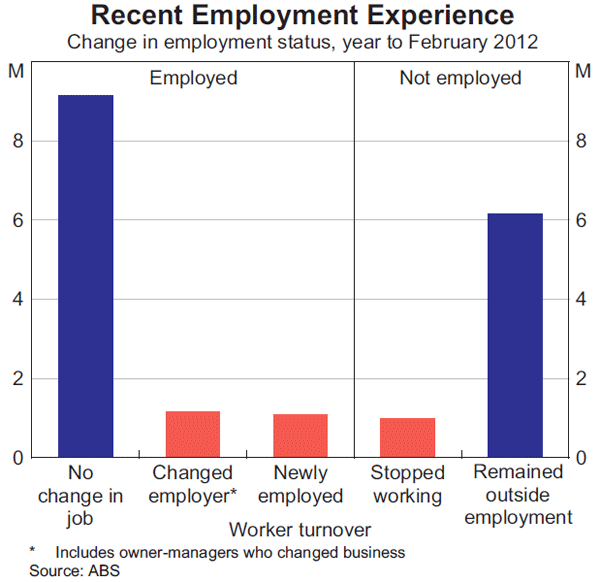
As noted by Sweet (2011), labour turnover and job tenure are opposite sides of the same coin. The data on labour market turnover indicate that around one in five workers have typically been in their current job for less than a year. The job tenures of the remaining majority are distributed with a very long tail: the average tenure for all workers is around 7 years, more than 40 per cent of employed workers have been in their current job for over 5 years, and 25 per cent have been in the same job for more than 10 years (Graph 2). The high incidence of long job tenure indicates that many workers and firms value the certainty and benefits of experience associated with job stability.[2]
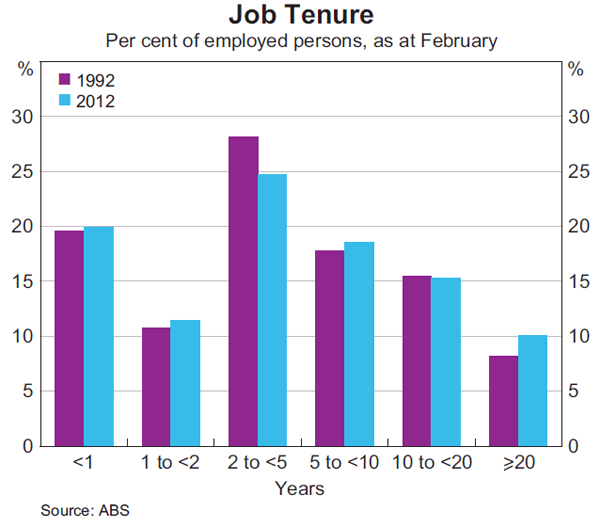
One implication of the observed distribution of job tenure is that job stability is very unevenly distributed across workers. While on average one in five workers experiences a change in their employment situation each year, individuals' experiences vary a lot: some workers change their job situation quite often while a relatively large group of workers change jobs very rarely. In part this reflects differences in turnover by age, gender and across industries, but it also reflects differences in individuals' strength of attachment to employment. Nevertheless, the share of workers with long tenure has increased over recent decades, suggesting that job stability on average may have actually risen despite a modest increase in the rate of casual employment over the course of the 1990s.[3] This increase in tenure is partly due to the absence of a severe cyclical downturn over the past two decades.
Drivers of Labour Market Turnover
Some insight into labour market turnover can be obtained from the data on the reasons why workers separate from their job. It is useful to distinguish between two broad types of job separation based on whether it is the firm's or the worker's decision to separate. ‘Involuntary’ job separations are initiated by firms and account for about a third of all separations, while ‘voluntary’ separations are initiated by workers and account for around two-thirds of all separations (Table 1).[4] Involuntary separations include retrenchments and temporary jobs ending.[5] Voluntary separations can be classified as ‘job-sorting resignations’, where workers leave a job with the intention of beginning or finding another job, or separations for life-cycle and personal reasons.
| Type | Number '000 | Share of all separations Per cent |
|---|---|---|
| Involuntary | 813 | 32 |
| – Retrenchments(a) | 390 | 15 |
| – Temporary jobs ending(b) | 423 | 17 |
| Voluntary | 1,702 | 68 |
| – Job-sorting(c) | 912 | 36 |
| – Life-cycle and personal reasons(d) | 790 | 31 |
| Total | 2,514(e) | 100 |
|
(a) Reasons include retrenched or employer went out of business Source: ABS |
||
In theory both types of involuntary separations – retrenchments and temporary jobs ending – may be either a job closure (where a firm decides that the job is no longer economically viable and does not intend to replace the worker in that job) or a dismissal (where the intention is to find a more suitable replacement worker). Although the ABS data do not distinguish between job closures and dismissals, retrenchments are likely to be a good proxy for job closures.
From a macroeconomic perspective, retrenchments are important because they are driven by cyclical and structural developments, and include jobs lost when a firm closes or downsizes its workforce, as often occurs in economic downturns. They are also driven by structural developments, such as changes in technology or the loss of competitiveness in a particular industry, that force firms to adjust their workforce by closing some jobs.
Separations from temporary jobs ending also reflect both job closures and dismissals. The number of temporary jobs ending has increased as a share of separations over recent decades. Although some jobs are inherently temporary in nature, it is possible that firms have increasingly used temporary employment to avoid some of the costs associated with dismissing unsuitable permanent employees. It could also reflect the increasing significance of temporary employment in the services sector.
Involuntary separations are countercyclical and negatively correlated with aggregate employment growth. This largely reflects the cyclical developments that drive job closures. Involuntary separations rose sharply during the economic downturns of the early 1980s, early 1990s, and during the global financial crisis of the late 2000s (Graph 3); on each occasion the spikes in retrenchments contributed to a significant and persistent rise in the unemployment rate. The pick-up in involuntary separations in the 2010 and 2012 data, from low levels in the mid 2000s, is one indication that job losses associated with structural change have been a feature of economic developments over the past few years. Although retrenchments declined in the latest data for 2012, separations from temporary jobs continued to rise. The increasing use of temporary positions may itself be a response of firms to the uncertainty associated with structural adjustment.
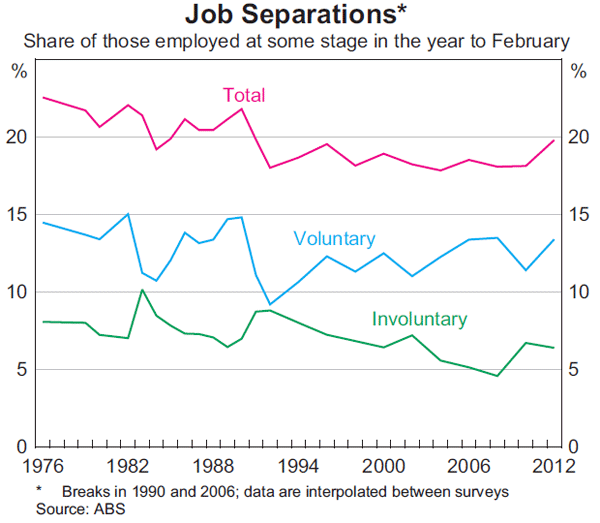
A major cost associated with job turnover is that most workers who lose their job involuntarily experience a period of unemployment. Of those experiencing an involuntary separation during the year to February 2012, only one-third had regained employment within the year and some of these will have experienced a short period of unemployment between jobs (Graph 4).

Younger workers are more likely to experience an involuntary separation than more mature workers (Graph 5). This may be because firms have less incentive to retain inexperienced staff when economic conditions change or because firms in industries with a high share of young workers are more vulnerable to negative shocks.
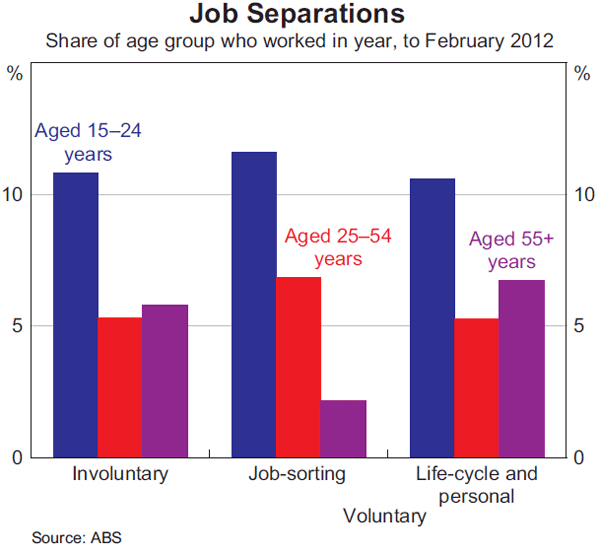
As mentioned earlier, voluntary separations are initiated by workers. They can be divided into job-sorting resignations and separations for life-cycle or personal reasons. These types of separations each account for around a third of all separations. Of course in some cases both motivations may be at work but each separation is classified only once.
A range of factors influence the number of voluntary separations in the economy. In the main, they will be associated with individuals' career paths and personal circumstances and will not reflect macroeconomic or structural developments. A large share of voluntary turnover will simply reflect resignations associated with workers moving between jobs that already exist. Young workers in particular are more likely to leave one job for a better job. Young workers are also less attached to the labour market while they are still undertaking education, and so will enter and exit the labour market during these years as circumstances permit. For prime-age workers, job-sorting resignations are a smaller share than for younger workers as these more mature workers have had time to find and become established in more suitable jobs. Rates of separation for life-cycle or personal reasons are also lower for prime-age workers. Nevertheless, separations by prime-age workers still account for the bulk of all separations that were for life-cycle or personal reasons, and are dominated by women leaving employment for family reasons, including having children. Life-cycle related separations are also significant for older workers who retire or stop working because of ill health. Given this, older workers are less likely than other workers to leave for another job.
Although voluntary separations are primarily driven by individual circumstances, the overall rate is nonetheless influenced by cyclical and structural developments, which affect the number and types of jobs available for those seeking a job change. In contrast to involuntary separations, voluntary separations tend to be procyclical. This is consistent with workers being most willing to bear the costs and risks of changing jobs during periods of stronger labour market conditions and more reluctant and less able to initiate a move when aggregate employment prospects are deteriorating. The gains from leaving a job will also be higher in a tighter labour market when firms are competing more intensely for workers. To some degree, voluntary separations will also reflect structural developments as workers respond to economic incentives and pre-empt job closures by migrating to new jobs with better long-term prospects.[6] Overall, workers who choose to leave a job in order to improve their employment situation have very high employment rates subsequently when compared with workers who leave a job involuntarily (refer Graph 4).
Turnover by Industry and Structural Adjustment
An important dimension of job mobility is the role it plays in facilitating labour market adjustment within and between industries. The ABS data indicate that around half of all job movements involve workers shifting out of an industry while in the other half of cases workers change jobs but stay in the same industry. Data from HILDA indicate that movements between industries are much more likely to involve a change in occupation than movements within the same industry. This suggests that inter-industry moves typically require a greater degree of retraining than moves within the same industry, which overwhelmingly do not involve a change in occupation.
The extent of turnover is not uniform across industries, with some industries experiencing much higher rates of inflow and movement within the industry than others (Graph 6). On this measure, in the latest ABS data, mobility was highest in the accommodation and food services (‘hospitality’) industry and lowest in the public administration and safety industry. This variation across industries is likely to reflect the interaction of a range of factors, including differences in the characteristics of the employees (such as age and education levels), the characteristics of the firms, their competitiveness and the industrial environment, different industrial relations settings and the nature of the shocks hitting the industries.[7]
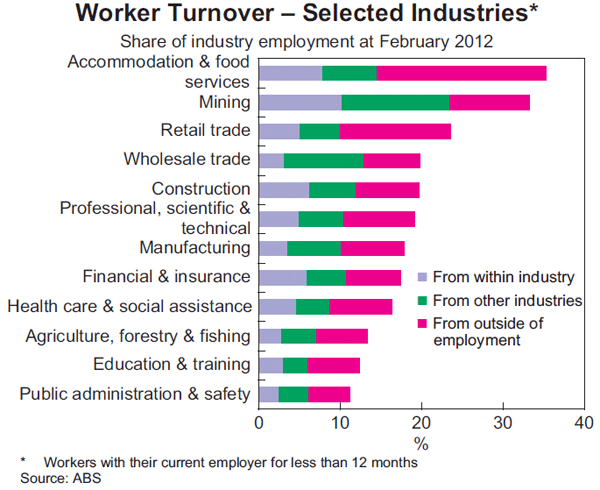
Without firm-level data on hires and separations and employee characteristics, it is difficult to disentangle the relative importance of the factors influencing turnover across industries. In general, however, turnover is lower in industries with higher average earnings and older workers.[8] This is consistent with workers having less incentive to move from jobs in which they have accumulated experience that adds to their earning potential in their existing job or industry. Conversely, younger workers with less experience specific to their firm or industry, and who typically earn relatively low wages, will not face the same disincentive to moving jobs.
The importance of job-specific experience partly helps to explain the large amount of turnover in the hospitality and retail trade industries, both of which have relatively young and inexperienced workforces. In contrast, workers in the health care & social assistance and education & training industries are older on average and are likely to have more specific on-the-job experience that makes movement costly. It is also likely that the high level of benefits, such as long-service leave, and the organised industrial relations environment in these largely public sector industries also reduce the degree of mobility. The relatively high rate of turnover in the mining industry in the latest data contrasts with earlier in the decade when inflows, in particular, were much lower. The pick-up in turnover is related to the rapid growth in employment, which has seen more new workers enter, but also more existing workers changing jobs as competition for labour in the industry encouraged more intra-industry job moves (Graph 7).
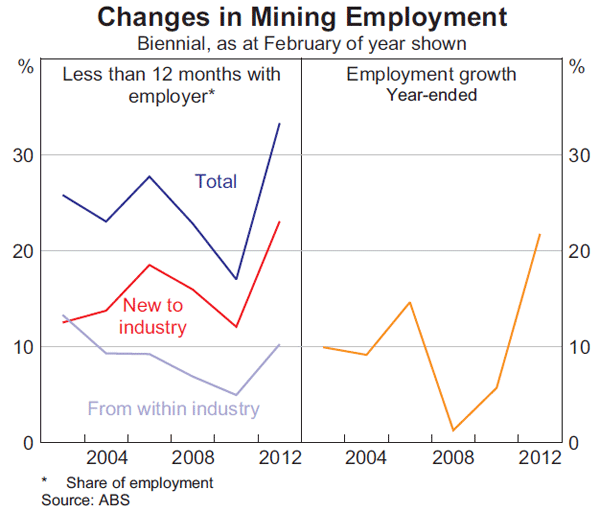
An important aspect of mobility between jobs is the extent to which it contributes to shifting the supply of labour as changes in the industrial structure of the economy alter the relative demand for labour between industries. It is difficult to measure these flows, but using the HILDA data together with the ABS labour force data it is possible to produce estimates of the size of direct flows between industries and their contributions to labour market adjustment over the past decade.[9]
A key feature of the estimated inter-industry flows is that a large share of total flows is accounted for by outflows from just 2 of the 19 industries: retail trade and hospitality (Graph 8). At the same time, these two industries also absorb a large share of new entrants to the labour market, with the combined inflows of new workers to these two industries almost as large as all new entrants to all other industries. This is consistent with relatively low-paid jobs in retail and hospitality being the first ‘rung’ on young workers' career ladders, with young workers making up a disproportionate share of employment in these industries.
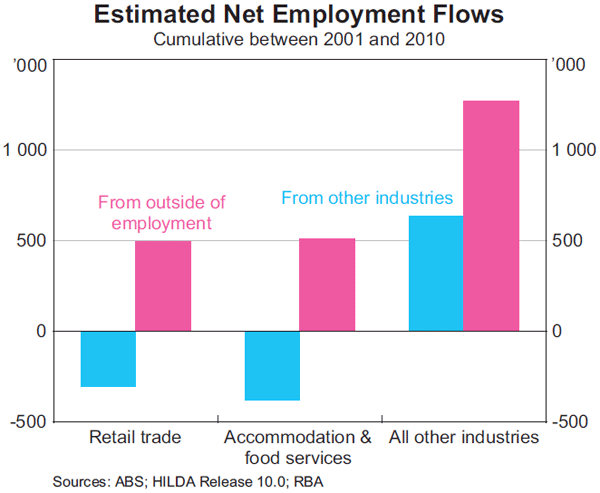
Overall, for industries outside retail trade and hospitality, inflows of workers from other industries are about half the size of inflows of new entrants from outside the labour market (Graph 8). Graph 9 shows estimates of the sources of employment growth for a number of industries, separately identifying the contribution from workers in the retail and hospitality industries, those previously employed in other industries and those from outside employment. For the majority of industries, direct inter-industry inflows have contributed between one-quarter and one-half of cumulative employment growth over the past decade. Many of these direct flows are workers from retail trade and hospitality, which will often be young workers. For most industries, the bulk of employment growth has come from workers outside of employment. The estimates of the inflows of workers from outside of employment will capture some instances where workers have moved indirectly between industries, via a transitional period outside of employment, as well as the normal flows of first-time entrants to the labour market and the flow of workers permanently leaving employment. However, these indirect transitions are relatively small. Overall, it appears that direct transitions and the flow of new workers into expanding industries were both important in facilitating the adjustment in the industry composition of employment over the past decade.
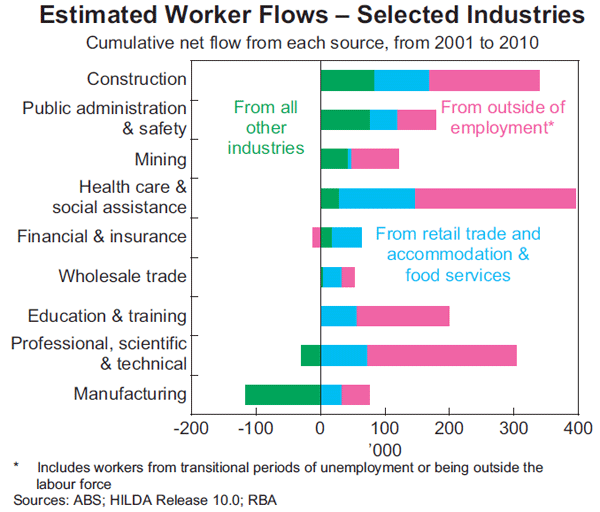
The relative importance of each source of workers varies considerably across industries. Other than the retail and hospitality industries, manufacturing is the only industry for which there has been a material net outflow of workers to other industries. This indicates that natural attrition and inter-industry worker flows have helped to accommodate the decline in the relative size of manufacturing employment over the past decade. In contrast, industries with stronger employment growth over the decade, such as construction and mining, have attracted workers from other industries. There is some evidence that these flows have become larger in the latter part of the past decade as the pace of structural adjustment associated with the expansion of the mining industry has accelerated. For instance, the estimated number of workers leaving manufacturing to work in other industries almost doubled in the five years to 2010, compared with the previous four years. At the same time, the number of workers moving to the mining industry from other industries more than doubled.
Geographic Mobility
Another important aspect of labour mobility is the role it plays in ensuring that the supply of labour responds to the changes in the location of jobs. When there are large divergences in the growth of labour demand across regions, the efficient operation of the labour market will require some workers to move permanently or to commute long distances. Of the 10 per cent or so of workers changing jobs in a year, the HILDA data suggest that only around 1 in 20 relocate interstate as part of the job change (less than 1 per cent of all workers).[10] Although this is only a small share of overall worker turnover, interstate migration has nevertheless made an important contribution to accommodating differences in the pace of employment growth across states over the past decade. It also contributes to the balance of demand and supply more generally.
Since early 2002, employment growth in Queensland and Western Australia has exceeded national employment growth by over 10 percentage points. Employment growth in the other states and territories (except the Northern Territory) has been slower than nationally. Estimates based on labour force data indicate that some of the extra workers needed to match stronger growth in employment in Queensland and Western Australia have come from within each of these states through a combination of larger increases in participation rates and larger declines in unemployment rates than occurred at the national level, as well as through stronger natural population growth (Graph 10). Nevertheless, these states also needed an inflow of labour from other states and from overseas. Both states had higher rates of net immigration from overseas and interstate than the national average, though Western Australia has been more reliant on the former, whereas interstate immigration was relatively more important for Queensland. Net outward migration from New South Wales and the smaller states has provided workers to the faster-growing states.
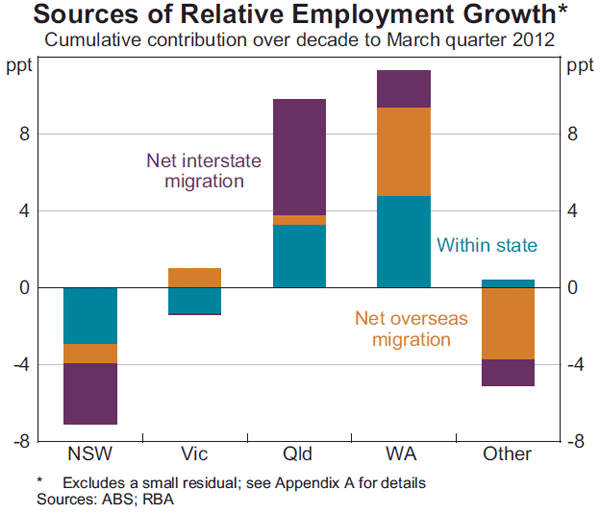
Overall, these estimates indicate that although interstate job moves are small compared with the aggregate number of job changes, they nevertheless have made a material contribution to the adjustment in the shares of employment across states. This is consistent with previous research for Australia that has found that migration is an important mechanism of labour market adjustment (Debelle and Vickery 1998; Lawson and Dwyer 2002).[11]
The different experiences of Queensland and Western Australia in attracting workers from interstate to meet an increase in labour demand are likely to reflect the nature of the costs and benefits of relocating.[12] Western Australia has consistently recorded a lower unemployment rate, higher vacancy rate and higher average earnings than Queensland over the past decade. However, despite labour market prospects appearing to be stronger in Western Australia, it has attracted fewer workers from interstate than Queensland. There are two possible explanations for this. The first is that the non-economic costs of relocating to the west are perceived to be higher, perhaps because the amenity value of the job locations (in terms of lifestyle, social infrastructure, proximity to family and other networks) is perceived as being lower than in the eastern states. This is consistent with information from the Bank's liaison program suggesting that firms often find workers in eastern states reluctant to move west. The second possible explanation is that there is a skills mismatch, with workers in the eastern states often not having the necessary skills to fill the available roles.
An alternative to permanent relocation that allows workers to take advantage of stronger labour market conditions without incurring all of the costs is long-distance commuting.[13] This is particularly relevant when the work is not long term. Data from the 2011 Census suggest that around 1½ per cent of employed people commute interstate. This is around the same size as the group of employed people who had moved from another state in the previous year. While interstate commuters are a relatively small share of employment, they appear to have been important at the margin in recent years: between 2006 and 2011 there were significant increases in the number of commuters to Western Australia and the Northern Territory. The number of commuters to Western Australia more than doubled, to 13,600, with the net increase equivalent to 4 per cent of the net employment growth in Western Australia over that period. The data show that long-distance commuters disproportionately work in mining, construction and public administration. Most of the increase in commuting to Western Australia was to regional areas, where much of the mining-related work takes place.
This long-distance commuting – both by flying and driving – has been a defining characteristic of the current mining boom and helped employers to meet their labour demand requirements given the reluctance of workers to move permanently to remote areas. The increase in commuting discussed above partly reflects a significant increase in the use of fly-in fly-out and drive-in drive-out (FIFO/ DIDO) workers in mining and related roles due to the rapid growth in mining investment over the past 5 to 10 years.[14] Census data and other industry sources suggest that there are currently upwards of 50,000 FIFO/DIDO workers involved in mining and mining-related construction. In some mining regions – such as the Pilbara and the Bowen Basin – 30 to 40 per cent of all 25–54 year olds appear to be FIFO/DIDO workers, which is a 50 per cent rise in the shares since 2006 (Graph 11). This increase is also apparent in transportation data: over the past decade, passenger movements to and from airports located near mining towns grew by 10 to 20 per cent per year, compared with 5 per cent annually for the whole domestic air travel network.
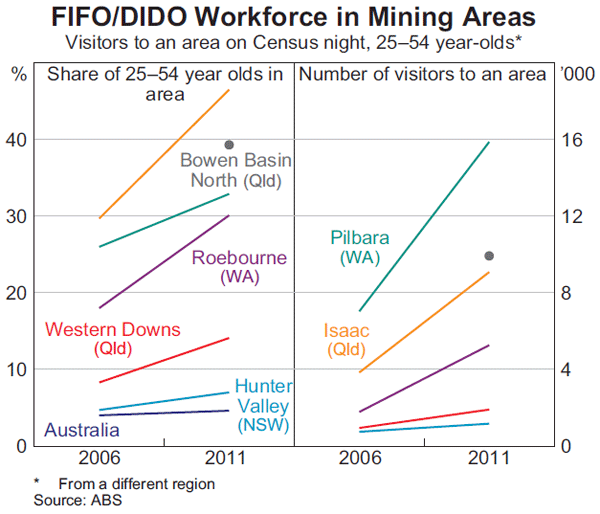
FIFO/DIDO arrangements can benefit workers, employers and businesses operating in towns near remote mines. However, these arrangements can also impose costs on local townships, including: high rents and property prices, overuse of roads and other community services and the lack of available labour and high wages for other local industries. The effects of FIFO/DIDO arrangements on regional Australia are currently being investigated by the House of Representatives Standing Committee on Regional Australia.
Conclusion
This article highlights a number of stylised facts about the operation of the labour market. While around one-fifth of workers experience a job separation annually, most workers are in long-term positions and change jobs only occasionally. Most labour market separations are voluntary and associated with workers seeking more suitable jobs or leaving employment for career or life-cycle related reasons. Nevertheless, job turnover is influenced by cyclical and structural economic developments which change the nature and number of jobs available in the economy. This is most evident in the fluctuations in involuntary separations, which tend to rise when firms are forced to close jobs and retrench staff during cyclical slowdowns or periods of structural adjustment. Although involuntary separations in recent years have been lower than in earlier decades, there is some evidence that the degree of structural adjustment over recent years has seen a modest pick-up in involuntary separations when compared with the mid 2000s. Labour mobility appears to have assisted labour market adjustment over the past decade, with a significant contribution from workers moving between industries and states. However, in part reflecting the costs associated with mobility, much of the adjustment has also been accommodated by natural attrition and new workers disproportionately entering jobs in expanding industries and regions.
Appendix A
Sources of employment growth by industry
The estimates of sources of employment growth by industry presented in this article have been produced using data from both the HILDA Survey and the ABS Labour Force release. By looking at changes between consecutive years in the HILDA variables on ‘Current main job industry’ (jbmi61) and ‘Labour force status – broad’ (esbrd) for individual respondents, annual estimates of the number of transitions between industries, and into and out of employment for each industry, were produced. However, in the HILDA dataset, a relatively large number of workers had their industry classifications changed even though they remained with the same employer. To try to correct for these spurious industry reclassifications, transitions between industries were only considered actual transitions if the worker also reported having changed employer over the year (using HILDA variables pjsemp and pjmsemp). It is important to note that because the estimates use year-to-year movements, they are best thought of as estimates of direct inter-industry flows.
The number of employed 15 year olds was also estimated for each industry, as these workers are new entrants not captured by the transitions within the labour force. For each industry, these data were used to estimate the number of workers that remained in the industry, the net flow of workers from other industries, the net number of workers entering from unemployment or from outside of the labour force, and employed 15 year olds.
The estimated composition for each industry was then applied to the level of industry employment (Emp) reported in the Labour Force release, giving estimates of the actual size of the annual employment flows that contribute to employment growth:

For most industries, the estimated flows do not fully account for employment growth. The main reason for this is that the transitions within the labour force do not capture migrants that arrived or departed during the year. Due to its design, the HILDA Survey is not a comprehensive source of information on these year-to-year movements. In the results presented in this article, the residuals resulting from not having information on migrants have been included in the ‘from outside of employment’ component.
Sources of employment growth by state and territory
For each state and territory employment growth is decomposed into the contributions from the change in the ratio of employment to working-age population and the contribution from population growth as follows:


where Emp is employment, Pop is population, t−i is the base period and Δ is the change in the variable from the base period to time t.
In the first equation, the first term is the contribution of the increase in the employment rate, the second term is contribution from the increase in population and the third term is the interaction effect between the change in the employment rate and population growth. In the second equation, population growth is decomposed into its three components: natural increase, net interstate migration and net overseas migration. In practice, the interaction effect between higher employment rates and population growth is small, at a maximum of 2 percentage points of employment growth, and is excluded from the second equation and Graph 10.
For each state and territory estimates of each source of working-age population growth are obtained by combining the flows from the Australian Demographic Statistics release with annual estimates of the share that was of working age based on other ABS publications. As these do not exactly total the growth in working-age population in each state, they are scaled up to the total. In Graph 10, contributions of the employment rate and natural increase are summed to produce ‘within state’. The national percentage point contributions are then subtracted from each state's contributions, to assess the divergence from the national average.
Footnotes
The authors are from Economic Analysis Department. [*]
In this article, changes in employer and changes in business (in the case of owner-managers) are both included in ‘job changes’ and ‘turnover’, although owner-managers are a small share of employment. [1]
Many workers also experience a change in the nature of their job without changing employer; in the year to February 2012, 20 per cent of employees changed their usual hours, were promoted or transferred, or changed occupation but stayed with the same firm. [2]
Welters and Mitchell (2009) explore the relationship between worker characteristics and job security using the Household, Income and Labour Dynamics in Australia (HILDA) Survey; they characterise some workers as being trapped in casual employment that does not lead to more permanent forms of employment. [3]
Note that the classifications of involuntary and voluntary separations used in this article differ slightly from those in the ABS Labour Mobility release. In particular, because the main distinction here is the party that initiated the separation, separations due to ill health are classified as voluntary. [4]
Although in some cases it will be the worker's preference to take on and finish a temporary job, temporary jobs ending are categorised as involuntary separations as it is assumed that in most cases workers available for a temporary job are available for, and would prefer to, work in an ongoing job. [5]
Davis, Faberman and Haltiwanger (2012) find evidence that US workers are more likely to quit firms that are in relative decline. [6]
Watson (2011) explains the personal characteristics of those changing jobs in more detail. [7]
The correlations between measures of worker movements by industry (within the industry and into the industry) and measures of industry average wage levels (excluding mining) and average worker age are typically in the range of −0.4 to −0.7 and statistically significant at the 10 per cent level. [8]
The estimates in Graph 8 and Graph 9 capture direct transitions between industries as they are based on the accumulation of year-to-year industry transitions recorded in the HILDA Survey. Thus, they are likely to be lower estimates of the size of total inter-industry worker flows over the decade as some workers recorded as entering employment from outside of employment (‘new entrants’) may have indirectly moved between industries. That is, they may have been employed in another industry two or more years earlier but moved through a transitional period of being unemployed or outside the labour force. See Appendix A for further details on use of the HILDA data to estimate inter-industry job flows. [9]
Note that this is likely to be a lower bound due to the greater difficulty in retaining survey respondents who move long distances. [10]
It is possible that the responsiveness of migration to relative employment demand has increased in recent years. McKissack et al (2008) updated estimates from the Debelle and Vickery (1998) model and found the response of migration to be larger than in the original shorter sample. [11]
Research using micro-level data shows that for Australia and several other countries, rates of interstate movement are higher for people who have higher incomes and have no children, which suggests that the financial and non-financial costs of moving are an important factor in the decision to migrate. For example, see Berger-Thomson and Roberts (2012). [12]
We define commuting as the usual place of work being in a different state to the usual residence. Note that the Labour Force release will record commuters as being employed in their state of residence. [13]
These work practices involve a worker residing in accommodation near their workplace for a period of time while scheduled to work, before returning to their home when not working. [14]
References
Berger-Thomson L and N Roberts (2012), ‘Labour Market Dynamics: Cross-country Insights from Panel Data’, RBA Bulletin, March, pp 27–36.
Davis SJ, RJ Faberman and J Haltiwanger (2012), ‘Labor Market Flows in the Cross Section and Over Time’, Journal of Monetary Economics, 59(1), pp 1–18.
Debelle G and J Vickery (1998), ‘Labour Market Adjustment: Evidence on Interstate Labour Mobility’, RBA Research Discussion Paper No 9801.
Lawson J and J Dwyer (2002), ‘Labour Market Adjustment in Regional Australia’, RBA Research Discussion Paper No 2002-04.
McKissack A, J Chang, R Ewing and J Rahman (2008), ‘Structural Effects of a Sustained Rise in the Terms of Trade’, Treasury Working Paper No 2008–01.
Productivity Commission (2012), Annual Report 2011–12.
Sweet R (2011), The Mobile Worker: Concepts, Issues, Implications, National Centre for Vocational Education Research Report, Adelaide.
Watson I (2011), Does Changing Your Job Leave You Better Off? A Study of Labour Mobility in Australia, 2002 to 2008, National Centre for Vocational Education Research Report, Adelaide.
Welters R and W Mitchell (2009), ‘Locked-in Casual Employment’, University of Newcastle Centre of Full Employment and Equity Working Paper No 09–03.